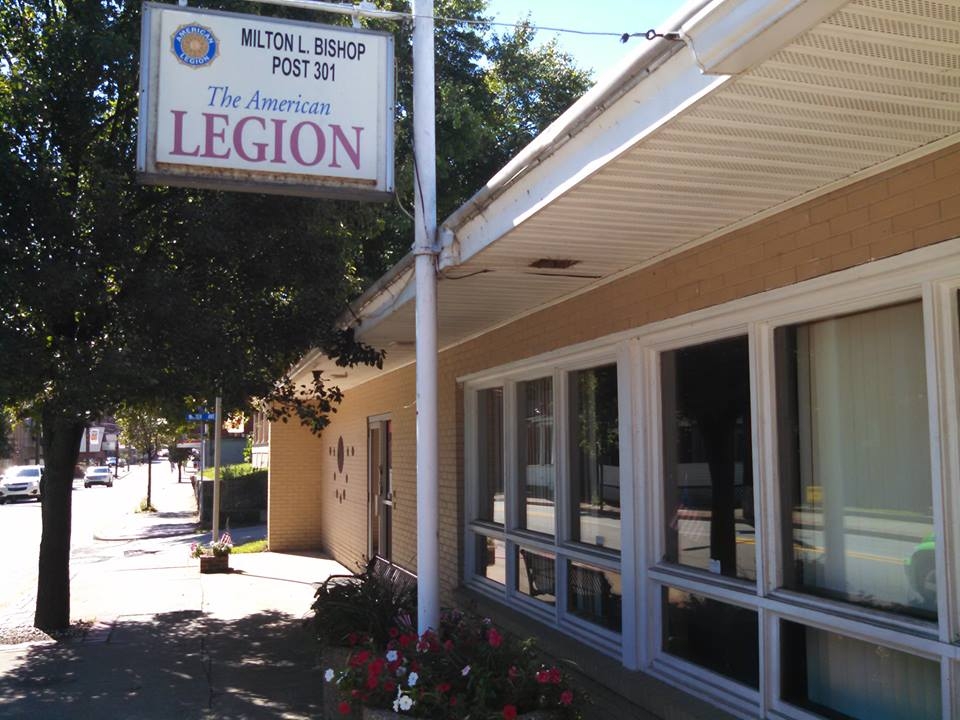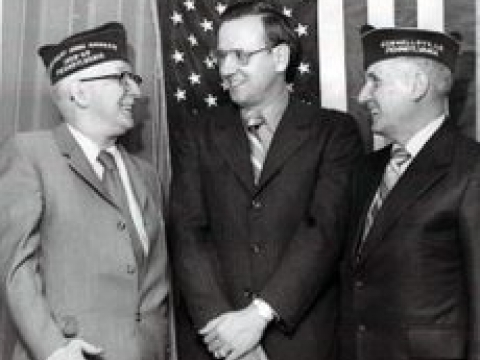Post 301 Milton L. Bishop Connellsville, Pennsylvania
- Home
- Post 301 Milton L. Bishop Connellsville, Pennsylvania
Post 301 Milton L. Bishop
Connellsville, Pennsylvania
About This Post
Post Namesake
Milton Lafayette Bishop was one of the most widely known young men of Connellsville. He was prominent in athletic sports, being a basket ball player and tennis player. He won his letter in basketball as a member of the varsity team of State College and was an honorary member of the Maccabee basketball team of Connellsville. Milton was born in Connellsville in the Bishop residence located at 107 West Crawford Avenue, (formerly called West Main Street) on May 3, 1893, the youngest son of A. W. and Alice May Bishop. With the exception of his four years at college he spent all his life in Connellsville. After graduating from the Connellsville High School in 1912, president of his class at the time, he entered State College, graduating in horticulture in 1916. He followed that occupation for only a short time, having not fully decided upon what career he would follow, when he joined the military. At one time he was employed by the Semet-Solvay Company at Dunbar. He enlisted in Company D, his three years enlistment expiring when he was at State College. When the company mobilized at the armory for duty in France he re-enlisted and at once was made a sergeant. Bishop was a member of the First Methodist Episcopal Church in Connellsville. In addition to his parents he was survived by one brother, Eugene Bishop of Chicago. Mr. and Mrs. Bishop had received no word from their son after he left the U.S. in which he lost his life.
Nine of Connellsville Command was killed in action; Company E. lost three men. Sixteen members of Company D, one of the 110th Regimental band, and several members of Company I fell in battle on the Aisne-Marne front the later part of July and August 1, according to telegrams which were sent out by the War Department to towns affected by the fighting.
Sergeant Milton L. Bishop was killed in action on July 30, 1918 at the age of 24, when a high explosive shell struck the headquarters of the 110th Infantry where he was located. His parents, Mr. and Mrs. Augustus William Bishop were notified by the War Department of his death. He was buried in Courmont, France by Chaplain Chas Schall, Sr.
Other towns also represented by members of the old “Fighting Tenth.” The casualties in Company D as reported during that day were:
Sergeant Milton L. Bishop, Connellsville 24 years old
Corporal Howard Sechrist, Connellsville
Private Francis L. Erb, Connellsville
Private Charles F. Graham, Connellsville
Corporal Clifford Shaffer, Shamrock
Corporal Patrick J. Cook, New Salem
George R. Rankin, Fairbanks
Raymond Renninger, Uniontown
Robert P. Wilson, Oliver – Severly Wouded
Sergeant Wilbert M. Stillwagon, Connellsville
Private Elmer Camper, Connellsville
Charles Augustine, Uniontown
James Skiles, Uniontown
Josephus C. Baer, Masontown
Herbert Weir, Coolspring
Tony Cavalcante, Edenborn
Notable Members
Max Floto & Thomas W. Scott - Founders of Armistice Day which led to Veterans Day in America.
Mrs. A.W. Bishop -
The Women’s Auxiliary to the Milton L. Bishop post was organized in October 1919. The national organization approved the organization of what was known as “The Women’s Auxiliary to the American Legion,” to be composed of mothers, wives, sisters, daughters and widows of service men. The Connellsville auxiliary is believed to be the first one to be formed in the United States.
The Daily Courier reported in an article dated 09 December 1919 – The American Legion under the constitution of the legion to be chartered by the national organization for the benefit of the wives, mothers, sisters, and daughters of men who served between April 6, 1917 and November 11, 1918, and the widows, mothers, daughters and sisters of those who made the supreme sacrifice within the same dates. Mrs. Bishop was the first chairman of the Auxiliary.
What Makes this Post Unique
The Milton L. Bishop Post 301 was the Father of Armistice Day in American which led to Veterans Day
The Milton L. Bishop Post 301 Organized the First American Legion Women's Auxiliary in the United States
The History of Armistice Day and the Milton L. Bishop Post 301
At the second meeting of the Milton Bishop Post 301 of the Legion in early 1919, Max Floto made a motion to promote Nov. 11 -- the date of the war's armistice -- as a national observance. That step, strongly supported by his fellow veterans, was the first in an effort that took nearly 20 years.
From there, Max Floto and fellow veteran Thomas W. Scott served as delegates to the state Legion convention in Harrisburg. There, Oct. 2, he gained the support of the state group. He then went to Harrisburg and was successful in persuading Governor William Cameron Sproul to issue a proclamation for the observance that year in the state. Ultimately, the state Legislature passed an act that made the holiday official in Pennsylvania. The two Connellsville men were delegates to the first national convention of the American Legion, coinciding with the Armistice. There, their holiday resolution was the second passed by the new organization's national body. But the effort was just the beginning. It took the federal government 19 years, until May 13, 1938, to make it a national holiday. Until that was achieved, Max Floto and supporters had worked with congressmen and others. Virtually every year, a resolution was presented in Congress to no avail, until President Franklin D. Roosevelt finally signed the bill in 1938.
From Armistice Day to Veterans Day
American effort during World War II saw the greatest mobilization of the U.S. Army, Navy, Marines and Air Force in the nation’s history (more than 16 million people); some 5.7 million more served in the Korean War.
In 1954, after lobbying efforts by veterans’ service organizations, the 83rd U.S. Congress amended the 1938 act that had made Armistice Day a holiday, striking the word “Armistice” in favor of “Veterans.” President Dwight D. Eisenhower signed the legislation on June 1, 1954. From then on, November 11 became a day to honor American veterans of all wars.
The next development in the story of Veterans Day unfolded in 1968, when Congress passed the Uniform Holidays Bill, which sought to ensure three-day weekends for federal employees—and encourage tourism and travel—by celebrating four national holidays (Washington’s Birthday, Memorial Day, Veterans Day and Columbus Day) on Mondays.
The observation of Veterans Day was set as the fourth Monday in October. The first Veterans Day under the new law was Monday, October 25, 1971; confusion ensued, as many states disapproved of this change, and continued to observe the holiday on its original date.
In 1975, after it became evident that the actual date of Veterans Day carried historical and patriotic significance to many Americans, President Gerald Ford signed a new law returning the observation of Veterans Day to November 11th beginning in 1978. If November 11 falls on a Saturday or Sunday, the federal government observes the holiday on the previous Friday or following Monday, respectively.
The American Legion Womens Auxiliary - First in Nation
The Women’s Auxiliary to the Milton L. Bishop post was organized in October 1919. The national organization approved the organization of what was known as “The Women’s Auxiliary to the American Legion,” to be composed of mothers, wives, sisters, daughters and widows of service men. The Connellsville auxiliary is believed to be the first one to be formed in the United States.
The Daily Courier reported in an article dated 09 December 1919 – The American Legion under the constitution of the legion to be chartered by the national organization for the benefit of the wives, mothers, sisters, and daughters of men who served between April 6, 1917 and November 11, 1918, and the widows, mothers, daughters and sisters of those who made the supreme sacrifice within the same dates. Mrs. Bishop was the first chairman of the Auxiliary.


